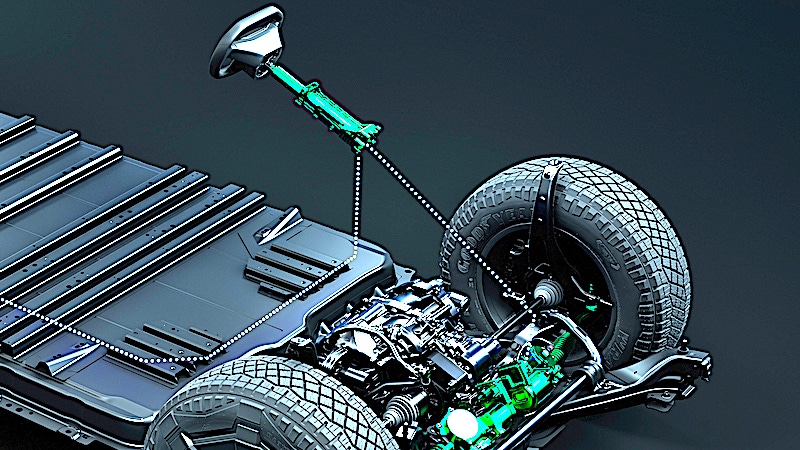CyberTruck Steer-By-Wire Prompts the Question of New Regulations
This has been unregulated, but the emergence of steer-by-wire systems such as in the Tesla CyberTruck will likely bring new requirements.

Tesla’s CyberTruck employs technologies we’ve seen elsewhere previously, such as 48-volt electrical components and an electric steer-by-wire system. However, the CyberTruck is the first to entirely do without a 12-volt electrical system, and the company’s steer-by-wire system seems poised to motivate some government regulation of this emerging technology.
That’s because while Nissan’s premium Infiniti brand introduced its Direct Adaptive Steering electric steer-by-wire system a decade ago, that system has always included a traditional mechanical rack-and-pinion steering system as a fail-safe in case of failure of the electric system. Tesla’s CyberTruck, predictably, forgoes the backup system.
CyberTruck’s steer-by-wire system confers the advantage for regular drivers of a small turning radius and quick response in low-speed turning situations like making a three-point turn. The advantage for Musk is apparently the ability to fit a steering yoke in place of a steering wheel, which lets him make “pew-pew” noises while pretending to pilot his tactical fighter rocket over the surface of Mars.

Infiniti's Direct Adaptive Steering steer-by-wire system retains a mechanical steering column connected to the car's steering rack. INFINITI
Michael Hales and Kathryn Pattok, of steering system supplier Nexteer Automotive, wrote in their paper, Safety Standards for Steer-By-Wire Systems, that important considerations when deploying such systems include different failure modes that are unique to steer-by-wire, what constitutes a safe operating state, how long a vehicle should be allowed to operate when a next electrical component failure would lead to violation of a safety goal, and what vehicle operating conditions are acceptable as a safe state. They caution that answers to these questions vary significantly, with approaches and philosophies largely left to individual vehicle manufacturers. Which, as exemplified by Infiniti’s decision to include a mechanical backup system for that company’s steer-by-wire system while Tesla has chosen not to take that route with the CyberTruck.
As a Silicon Valley company whose leader advocates a minimum-viable-product approach, it is unsurprising that Tesla would not install a mechanical backup system. This could be fine, depending on how the CyberTruck’s steer-by-wire system is designed to respond to problems. Alas, Tesla does not make employees available to speak with the media about such things.
However, looking at the company’s record with technologies such as the Autopilot advanced driver assistance system (ADAS) which has been recalled with a software update for its failure to properly monitor driver attention while the system is in operation, we can guess that the CyberTruck’s steer-by-wire failsafe mode might be riskier that Tesla drivers or those who share the road with them might prefer.
“The general ethos of Silicon Valley is to move fast and break things,” noted Shaun Kildare, senior research director for Advocates for Highway Safety. “While that may work well for some sectors of the economy, it does not work well when applied to technology whose performance results in life-or-death consequences,” he added. “Prematurely rushing unproven technologies into motor vehicles and onto public roadways can result in preventable fatalities and injuries. Safety standards are critical to ensure that technology performs as needed, instead of using the public as unwilling test subjects.”
Toyota has announced plans to introduce steer-by-wire into the company’s RZ 450E without a mechanical backup system. Instead, Lexus will use a redundant electric system as backup, complete with a separate controller and CAN bus wiring. Tesla may do that as well, but because the company provides no technical information to the press or access to the company’s engineers, we don’t know.
Regulations that are surely brewing will ensure that companies follow agreed-to safety requirements for these systems so that we can feel safe sharing the road with such cars. The August 2018 report from the National Highway Traffic Safety Administration, Functional Safety Assessment of a Generic Steer-by-Wire Steering System With Active Steering and Four-Wheel Steering Features provides some direction of what we can expect with a list of ten areas that have functional safety requirements to be examined.
General Steer-by-Wire
S-b-W Control Module
Driver Steering Input Sensor
Driver Feedback Assembly
Steering Actuator Assembly
Power Source
Communication System
Interfacing System
Rear-Wheel Assembly
Mechanical Backup Steering Assembly
This list underscores that there is more to consider than a simple steering wheel angle sensor and force feedback motor in the steering column matched with an actuator in the car’s steering rack. Once some clear requirements are in place for the reliability and redundancy of these many systems, drivers can contemplate the convenience benefits of steer by wire without concern for potential safety shortcomings.
About the Author(s)
You May Also Like





